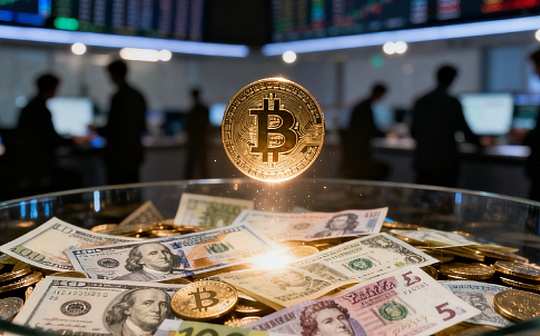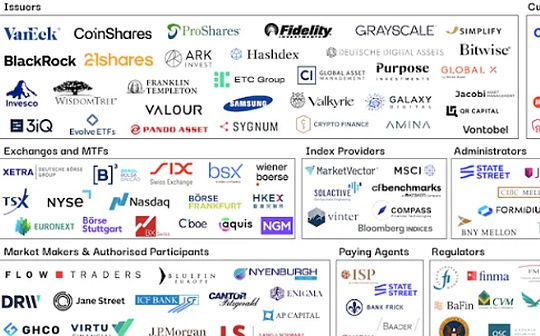
Author: Diana Biggs, 1KX; Translation: 0xjs@作 作 作 作 作 作
Exchange trading products (ETP) provides retail investors and institutional investors with a convenient, supervised and low -cost way to obtain a series of basic investment, and cryptocurrencies are no exception.
Since Sweden launched the first product to track Bitcoin in 2015, cryptocurrency ETP has continued to expand from mainly in Europe to global footprints, and from only 17 products at the end of 2020 to about 180 transactions today.As more and more Tradfi agencies have joined the ranking of crypto native companies, ETP not only has the role of expanding the opportunity of investors to obtain cryptocurrencies, but also changes in the overall acceptance and integration of cryptocurrencies in the global financial market.It is getting more and more obvious.
Overview of this article encrypted ETP, including the currently available product types, operating models, regional overview, and development in this rapid evolution.
Overview of cryptocurrency ETP
What is cryptocurrency ETP?
Exchanges trading products (ETP) are financial products bought and sold for stock exchanges that are regulated by a normal trading time every day.
ETP is mainly divided into three types: exchange trading funds (ETF), exchange trading bills (ETN), and exchange trading products (ETC).ETF is an investment fund, while ETN and ETC are debt securities. ETC tracks physical products such as gold and oil. ETN is used for all other types of financial instruments.Since the establishment of the first ETF in 1993, it has been thirty years since the development of ETP has been tracked from the stock market to one of the most innovative investment product categories, providing investors with a series of innovationInvestment opportunities for underlying assets.
Note: Although “ETP” is the general name of such products, the term “ETP” is sometimes used as a category term for debt securities exchanges trading products.
Especially in the past two decades, such products have continued to grow. Of the 718 providers listed on 81 exchanges in 63 countries around the world, 11,859 products and 23,931 were listed; of which, ETF accounted forThe largest share of assets accounts for US $ 107,47 billion, accounting for 98%of the total amount of ETP assets of US $ 10990 billion (data from ETFGI as of the end of November 2023).Oliver Wyman predicts that ETF growth will accelerate in recent years, predicting that the market will grow from 13%to 18%per year from 2022 to 2027.
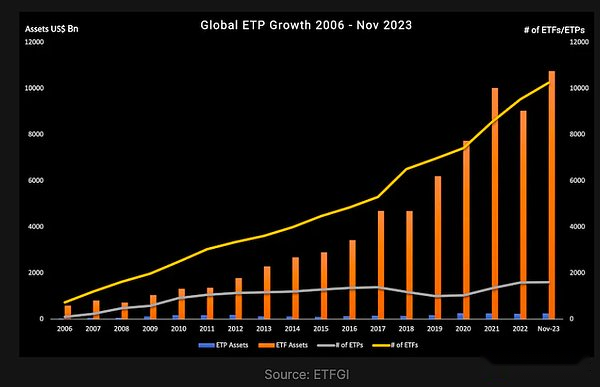 The convenience and accessibility of ETP make it a popular tool for opening new assets and investment strategies to investors -cryptocurrencies are no exception.
The convenience and accessibility of ETP make it a popular tool for opening new assets and investment strategies to investors -cryptocurrencies are no exception.
The first Bitcoin ETP ever was launched by XBT PROVIDER (later acquired by CoinShares) in 2015 in Nasdaq, Sweden.The growth of the market has been relatively mild. Until the second half of 2020, the number of products has begun to increase strongly. This situation has continued to this day. Whether it is from the new cryptocurrency native entry or traditional publisher.In February 2021, Canada won the world’s first Bitcoin ETF competition. Purpose Investment launched the Purpose Bitcoin ETF on the Toronto Stock Exchange.Although the cryptocurrency ETP constructed in the form of debt securities still far exceeds the cryptocurrency ETF in terms of quantity and asset management scale, we expect this situation to begin to change, especially with the opening of the US spot ETF market.
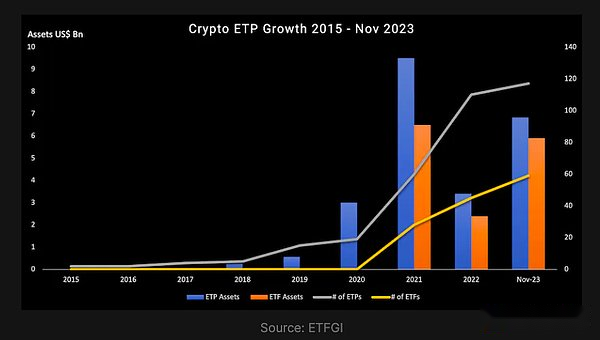
The number of cryptocurrency products has increased steadily, especially in the past three years, according to ETFGI data, as of November 2023, encrypted ETF and ETP reached 176 species.In the first 1123 months, assets invested in these products increased by 120%, from US $ 5.79 billion at the end of 2022 to US $ 12.73 billion at the end of November 2023.
Why choose encrypted ETP?
For encrypted natives, the idea of encrypted ETP seems to violate intuition: introducing intermediaries, and this technology eventually enables us to eliminate intermediaries.However, as an easy -to -understand and regulatory investment product, these products provide opportunities for more investor audiences to contact cryptocurrencies, and these investors may not be able to access the asset category for various reasons.For example, retail investors may lack tools, time, risk tolerance and technical knowledge of direct investment in cryptocurrencies.ETP is open to institutional investors as the structure of traditional securities. Institutional investors may only be limited to investing in these types of tools, or for supervision, compliance, technology, or other reasons, they hope to avoid directly holding encrypted assets.
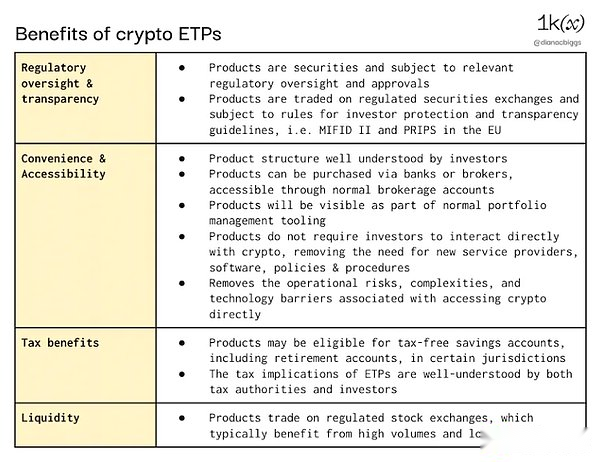
Compared with buying cryptocurrencies, there are potential shortcomings and considerations of these products (because not all investors will think these are shortcomings).Among them, the cost of cryptocurrency ETP so far is much higher than the typical costs of these products (although the costs are declining as the competition has increased); the trading availability of traditional exchanges compared with the cryptocurrency 24/7 market is limited availability.; Based on regulatory approval, trading opponents, tracking errors, exchange rate risks, and judicial jurisdiction and investor types determined by settlement time.
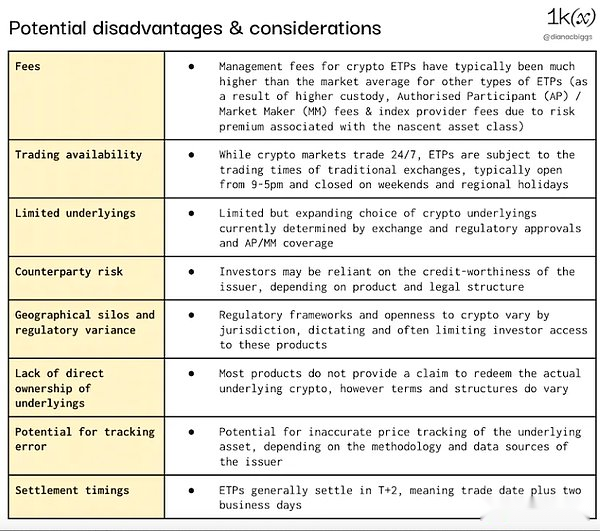
Note: Examples of regional restrictions include European cryptocurrency ETPs that are usually not registered according to the US Securities Law in 1933, so they cannot be provided to American investors;
Product structure and product
In a broad sense,Cryptocurrency ETP is divided into two product categories: ETF or ETP; two product types: physical (also known as asset support) or synthesis.
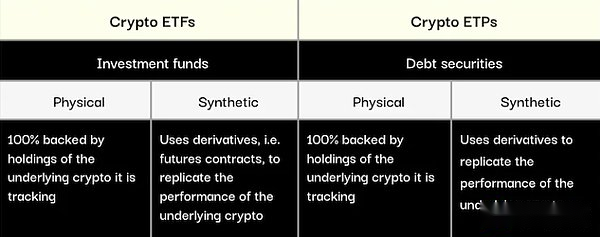
Cryptocurrency ETF structure
The structure of ETF is a fund, and the ETF holding is the fund share.It is usually protected by trust, investment companies, or limited partnerships to ensure that investors’ holdings are protected when the parent company/issuer is bankrupt.ETF usually needs to comply with additional rules and transparency requirements, depending on its jurisdiction; for example, ETFs registered in the European Union and selling to EU investors usually need to comply with UCITS (Undertakings for Collective Investment in Transferable Collective investment commitment) Regulations, which brings diversified requirements, for example, a single asset cannot represent 10%of the fund assets.
Most encrypted ETFs are now spot or futures products.The spot ETF has the direct ownership of basic crypto assets and is guaranteed by an independent custodian.For futures ETFs, the issuer does not hold basic cryptocurrencies, but for futures contracts that purchase assets.Therefore, these products do not directly track the spot price of the underlying assets, which are usually considered to bring greater complexity and cost, and for investors, transparency and intuitiveness are poor.
Cryptocurrency ETP structure
Cryptocurrency ETP (in this example, using this term to refer to products other than ETFs) is constructed as debt securities.Although their structural requirements are not as strict as ETF, their disclosure requirements are very similar.
The physical encryption ETP is a guaranteed debt securities, and 100%is supported by the basic cryptocurrency holdings tracked by it.The encrypted assets are purchased and held by the independent third -party custodian under the supervision and control of the trustee. The trustee represents rights and rights on behalf of ETP holders, and is responsible for organizing redemption when the issuer goes bankrupt.
Synthetic ETP is an unprepared debt certificate, which means that the issuer does not need to hold the basic assets that are being tracked by the product, but use derivatives and swaps to track financial performance (the exact structure and terms will be different).Therefore, the synthetic ETP bears a greater risk of transaction, because the law does not require that the product must be supported by basic physical assets.XBT Provider (CoinShares) and Valor are two encrypted ETP issuers that provide synthetic products.
In general, most cryptocurrency ETPs on the market are physical products, because many investors prefer the transparency and reduced transaction risk provided by this structure.
Encrypted product distribution
Cryptocurrency ETP initially started as a single digital asset tracking product. Today, the scope of cryptocurrency ETP provided on the market also includes single assets, one -basket assets, pledge, reverse and leveraged products, and some of the purpose of managing volatility.index.
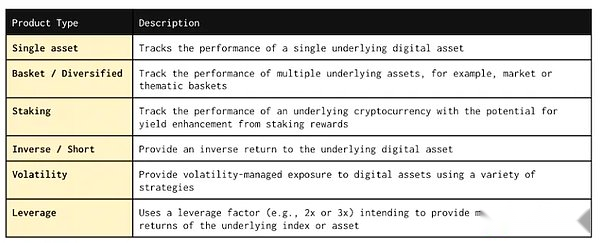
From the perspective of underlying securities, according to the recent data compiled by BitMex Research, excluding stocks and off -the -board trading funds, plus additional data, we found that in 162 cryptocurrency ETPs, Bitcoin, Ethereum and basket products account for 58%, Other products account for 58%.42%consists of long tail single digital assets, as well as short, volatility and leverage products.

162 encrypted ETP data (excluding stocks and off -site trading funds); data sources: Bitmex research, 1kx research
Among these 162 products, 121 are ETP and 41 are ETFs, of which 16 are futures ETFs, and 11 are the American spot Bitcoin ETFs waiting for launch.Praising products means that investors can benefit from the pledge income they hold. There are currently 14 types: 13 ETPs and 1 ETF.
The largest product calculated based on the scale of asset management
Calculated according to the scale of asset management,The largest cryptocurrency ETP is Proshares Bitcoin strategy ETFThis is a headquarters in the United States. According to the available data as of January 2, 2024, holding assets is $ 1.68 billion.
As shown in the table below,9 tracking Bitcoin (64%) of the 14 top cryptocurrencies ETP (64%); Among the five of the other five, including three tracks of Ethereum, one tracking solana, and one tracking BNB.
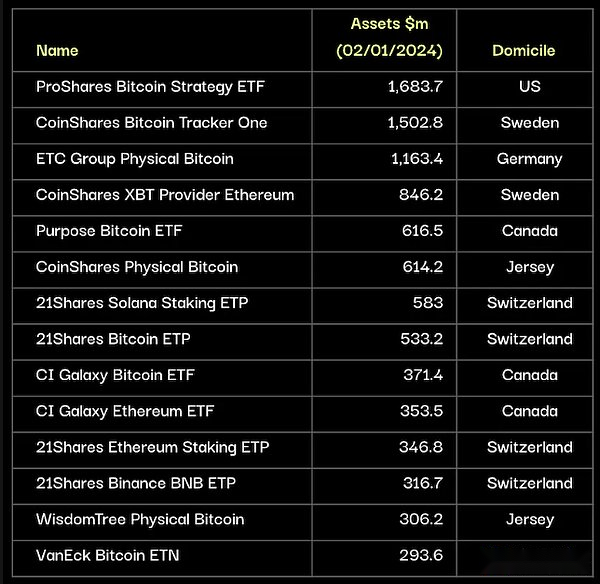
Source: Bitmex Study, 1KX Studies
Among these 14 products, four are registered in Switzerland (all from the publisher 21Shares), three are registered in Canada, two are in Jersey Island, one in Germany, one in the United States, and one in Liechtenstein.
Among the top 14 products ranked by assets, there are 4 types of ETF: 3 are spot ETFs, and one is Futures ETF.In ETP, eight are physical products, two are synthetic products.
Product innovation
When pushing the new encrypted ETP to the market, you need to consider several restrictions.These include the requirements and approval of supervision and stock exchanges, liquidity requirements, investor needs, and the availability of public price data and fiat currency transactions.In other words, as more and more participants enter the market, seek to occupy the market share and achieve differentiation, as well as the understanding and acceptance of this asset category with regulatory, service providers and investors, weSeeing the issuer and index providers continue to innovate product innovation.
Cryptocurrency ETP operation model
The creation of ETP starts with the issuer (that is, the investment company or trust), and write a prospectus for approval of the regulatory agency.These may be different due to the jurisdiction of the judicial area, but in general, they include the details of the issuer, including the identity, product and planning design of their directors and financial statements, including outline of basic assets, expected markets and service providers, comprehensive comprehensivePotential risk overview, asset valuation (NAV) and NAV calculation methods, costs and redemption processes.
After being approved by the regulatory agency and successfully hiring the necessary service providers, the issuer must apply for listing on the stock exchange.Regarding which types of products (that is, asset support or futures) and the rules of listing are eligible for listing, the rules of listing vary from exchanges.
The operating model and scope of service providers may vary from product types, jurisdictions, and publishers’ planning design.Overview of typical models is as follows:
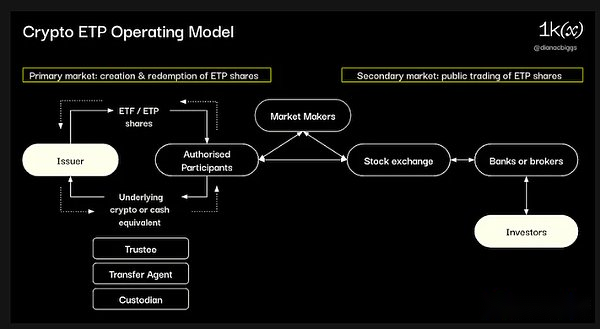
-
In the first -level market, the issuer exchanges product share with AP to exchange for the bidding assets (“physical”) or cash equivalent, and deliver the target encryption assets to the specified custodian or deliver from the designated custodian as needed.Depending on the structure, the transfer agent and trustee may participate in liquidation mortgage and transfer funds.
-
When the AP management first -level market is created and redeemed, the market merchants provide liquidity in the secondary market to ensure sustainable and efficient transactions.
-
Investors buy and sell products on the secondary market, usually placing orders through banks or brokers, and banks or brokers directly or via other intermediary agencies to perform orders on relevant stock exchanges.
Crypto ETP industry panorama

Issuer
The issuer is responsible for the overall design and creation of ETP, and coordinates and manage related intermediary agencies during the entire product life cycle.It is not necessarily necessary to regulate the issuer’s supervision because of the jurisdiction of judicial jurisdiction.However, the regulatory agency evaluates the issuer during the approval of the prospectus, as well as during the listing of the exchange, which may include corporate governance, capital requirements, and regular audits.The issuer usually set up an independent special destination agency (SPV) to distribute products.Initially, most encrypted ETP issues were encrypted native companies, such as CoinShares, 21Shares, 3IQ, HashDex, and Valour. In recent years, more and more traditional financial companies have joined, including Wisdomtree, VANECK, Invesco, Fidelity and waiting for SEC approval.Companies, Berlaide and Franklin Dunpon.
Custodian
The custodian holds the basic cryptocurrency supporting the product.The hosting agencies used by ETP issuers include Coinbase, Fidelity Digital Assets, Komainu, Bitgo, Copper, Swissquote, Tetra Trust, Zodia Custody and Gemini.
Be a city merchant
The municipal merchant (MM) is a liquidity provider hired by the issuer. By providing two -way offer to the exchange by providing a two -way quotation in accordance with the terms agreed in the contract, it provides necessary liquidity for ETP.This includes Flow Traders and GHCO.
Authorized participant
Authorized participants (APs) are usually banks or brokers, and have the right to directly create and redeem product share with the issuer every day.They do this by delivering the assets or their cash equivalents in exchange for the newly created ETP shares or returned the shares to the issuer’s asset or cash to do this.Participants’ interest in cryptocurrencies, especially for assets other than BTC and ETH, may be different due to factors such as supervision uncertainty and market conditions.APs active in the field of encryption ETP include Flow Traders, GHCO, Virtu Financial, DRW, Bluefin, and ENIGMA Securities.JP Morgan, Jane Street, and Cantor Fitzgerald & amp; Co recently listed as AP in the US spot Bitcoin ETF fileEssence
Index provider
The index provider is responsible for creating, designing, computing, and maintaining the index and benchmark of ETP tracking.These provide transparency and reliability for issuers and investors.In some jurisdictions, index providers are supervised, such as in the European Union, there are European benchmark regulations (BMR).liveIndex providers jumping in the encryption ETP include MarketVector Indexes, CF Benchmarks (acquired by KRAKEN in 2019), Vinter (Sweden’s encrypted native index provider), Bloomberg, and CompassEssence
Exchange and multilateral trading facilities (MTF)
The willingness of the exchange and MTF to list cryptocurrencies E EPP will first be approved by the regulatory authorities of local regulations and issuers’ prospectus, and then become business decisions determined by their respective issuers and product qualifications. They usually include multiple parameters for basic assetsEvaluation, such as liquidity, compliance, public pricing information and risk relief.Which types of products can be listed different from trading venues; for example, Xetra in Germany only listed ETPs supported by assets, and SIX Swiss Exchange has special rules for qualified cryptocurrency targets.
trustee
The trustee may be responsible for protecting the assets and representing the interests of ETP holders or investors.Their specific roles and responsibilities may vary from ETP’s specific structure and legal arrangements.The trustees active in encrypted ETP include Law Debenture Trust Corporation, Apex Corporate Trust Services, Bankhaus Von Der Heydt, and Griffin Trust.
Management agency
Administrators support the overall operation and management of ETP.Their services may include accounting, regulatory compliance, financial reports and shareholder services.Management agencies active in encrypted ETP include Daofu Bank, JTC Fund Solutions, Bank of New York, Formidium, Nav Consulting, Theorem Fund Services, and Cibc Mellon Global Securitys Services.
Other service providers
Other service providers that may play a role in the ETP plan and product life cycle include, but not limited to the payment agent (responsible for registering new ETP units and obtaining Isin from local institutions), transfer agents (can be used to maintain) shareholders and other responsibilities recordsCalculate agents, the net asset value used to calculate the basic assets, and registers to preserve shareholders’ records.According to product types, issuers and jurisdictions, these different roles and responsibilities may overlap and/or be borne by different parties.
Explanation of expenses
ETP is charged for management fees, also known as expense ratios or sponsor fees. The cost of paying management and operating products is calculated at the percentage of the position per year, and the daily or regularly deducts from the net asset value.Many early cryptocurrency ETPs can charge up to 2.5 % of high costs, and the cost range of ETP is usually between 0.05 % and 0.75 %.When the alternative charging is as low as 0%, the AUM charging of the encrypted ETP is 2.5%, which shows the viscosity and first -mover advantage of these products.
We expect the cost will become a key differentiation factor in the future of new products, as the American spot ETF is now seen.In the expenses announced so far, Invesco/Galaxy is exempted from the cost of the first six months and the first 5 billion U.S. dollars, Fidelity has charged 0.39%.
Regional product
Europe
Cryptocurrency ETP originated in Europe. The first Bitcoin product was launched in Sweden in 2015. It is a synthetic follow -up ETP issued by XBT PROVIDER (acquired by CoinShares in 2017).In Europe, the issuer of cryptocurrency ETP benefits from a single market, because once the ETP prospectus is approved by a European country regulatory agency, after notification and approval, the product can also be listed on other member states (called the “Pass” prospectus instructions))).Sweden’s SFSA is still a popular choice for European cryptocurrency ETP prospectus.Germany is another judicial jurisdiction that has been approved for cryptocurrency ETP prospectus, and cryptocurrency ETP has good availability in various trading venues, such as the cryptocurrency ETP from the German Exchange and Stugart Exchange Group.
ETP is still the dominant product type in Europe, and the reason for the lack of real encryption ETFs in Europe is largely due to the regulations of UCITs (transferred securities collective investment commitment).Overall, most European ETFs comply with UCITs regulations in order to benefit from pan -European Pass. In addition to registered countries, they are also allowed to sell these ETFs from retail investors from other EU member states, as well as guarantee and investor protection of these regulations providedEssenceHowever, UCITS rules and requirements are currently incompatible with single asset tracking products such as Bitcoin ETF.For example, UCITS diversification requires that any single asset must not exceed 10%of the fund, and the underlying asset must be a qualified financial instrument.In June 2023, the European Commission instructed the European Securities and Market Administration (ESMA) to investigate whether the UCITS rules need to be updated and pay attention to encrypted assets.However, the purpose of this move seems to determine whether more rules and investors’ protection are required, not the type of product that expands qualified.The deadline for ESMA opinion is October 31, 2024.
Switzerland
In 2016, Switzerland became the second jurisdiction of judicial jurisdiction after Sweden approved and listed on cryptocurrency ETP. This is the Bitcoin tracking product launched by Vontobel Bank on the Six Swiss Exchange.Subsequently, the world’s first encrypted index product was launched in Switzerland in November 2018. This is an ETP supported by a basket of physical support.ETH), Ripple (XRP) and Litcoin (LTC).Swiss SIX SWISS Exchange has special rules for cryptocurrency targets, including “when applying for temporary transaction permits, the cryptocurrency must be one of the 15 largest cryptocurrencies measured according to the US dollar market value”, and according to our research, this encrypted encryption, this encryptionCurrency has the most wide range of cryptocurrency bases in any global trading venue.The Swiss Stock Exchange BX SWISS also allows products with cryptocurrency bases. The rules include the basic currency must be within the top 50 cryptocurrencies in the market value.
U.K.
In October 2020, the British Financial Behavior Regulatory Administration (FCA) prohibited any derivatives or ETNs that mentioned, marketing, and distributing “non -regulatory encrypted assets” to retail investors.Many cryptocurrency ETPs are listed on the AQUIS Exchange in the United Kingdom for use for professional investors.
Canada
Canada is the first country to approve the Bitcoin ETF. Purpose Investments launched the first product on the Toronto Stock Exchange (TSX) in February 2021, and then launched Ethereum ETF in April of that year.In October 2023, 3IQ launched a pledge to its Ethereum ETF, and the pledge reward was included in the fund, which is the first time in North America.Other Canadian encrypted ETF issuers include Fidelity Investments Canada, Ci Global Asset Management (CI GAM), and Evolve Funds.
Brazil
Canada first approved the Bitcoin ETF, followed by Brazil, followed by the Brazilian Securities and Exchange Commission (CVM) in March 2021 the first Bitcoin Exchange Trading Fund (ETF) in Latin America.Brazil crypto ETF issuers include encrypted asset management companies HashDex and QR Capital, as well as ITAú Asset Management in cooperation with Galaxy.
USA
So far, only cryptocurrency futures ETF has been approved by SEC and opened to investors.PROSHARES launched the first Bitcoin Futures ETF on October 19, 2021, becoming one of the largest funds in market history, and attracted more than $ 1 billion in assets in the first few days of the transaction.

Source: Bloomberg, Eric Balchunas, senior ETF analyst from Bloomberg News Agency.
Two years later, on October 2, 2023, Proshares, Vaneck and Bitwise launched the first batch of Ethereum Etf ETFs in the United States.Futures products usually require investors to have more understanding, and bring additional costs and risk of tracking errors and decline in performance due to frequent re -balance.The basic futures contract is traded on the Chicago Commercial Exchange (CME) transaction under the supervision of the Commodity Futures Trading Commission (CFTC). This fact is a popular theory approved by Futures ETF before the spot ETF.
The WinkLevoss twin brothers submitted an application for the US spot Bitcoin ETF in July 2013, but in the following years, the application was repeatedly rejected.Ten years later, on June 15, 2023, BlackRock, the world’s largest asset management company, submitted the Ishares Bitcoin Trust Fund application.Their brand influence, plus their outstanding performance records (according to Bloomberg Senior ETF analyst Eric Balchunas, Berlaide has only been rejected once in 575 ETF applications), which has changed the rules of the game and helped the United States BitcoinSpot ETF has become one of the most anticipated ETFs.
On August 29, 2023, the trend further transformed. The Court of Appeal Court of Columbia Special Administrative Region in the United States made a ruling on gray in GrayScale in GrayScale’s SEC (22-1142) case, saying that the SEC decided to prevent the Bitcoin ETF that it proposed to prevent it from the proposed Bitcoin ETF.It is “arbitrarily and repeated.”
To this day, 11 issuers have submitted an application for the spot Bitcoin ETF and are being reviewed by the SEC (S-1 form link, including the prospectus documents and other information and evidence collected by the SEC, such as 2023 in 2023Submit files on December 26th, 28th, and 29th): BlackRock (Ishares), GrayScale TY, Valkyrie,HashDex and Franklin Templeton.In recent weeks, the conference between the SEC and the issuer has increased, and the SEC requires all issuers to turn to cash creation, which means that the asset exchange of the creation and redemption of the ETF share must be carried out in cash, not the real thing.Generally, for efficiency reasons, asset exchange between AP and ETF issuers in addition and redemption is performed in physical forms.Although the SEC has not publicly stated that it only requires cash, the SEC is likely to not want to be regarded as a approved AP (usually large banks and brokers) to conduct cryptocurrency transactions.
As of Friday, January 5, 2024, all 11 applicants have submitted the revised 19B-4 S. Among them, it is recommended that the exchanges amend the rules to achieve product transactions.These must be approved by the US Securities and Exchange Commission’s transaction and market sector.
Bloomberg News Agency, January 5, 2024 US spot Bitcoin ETF status excerpt
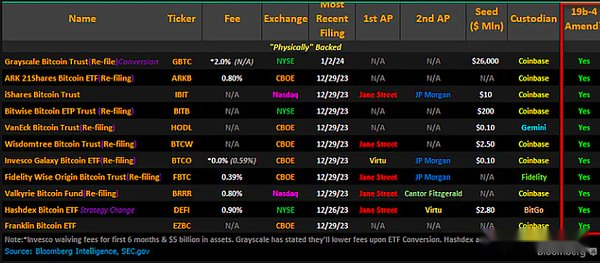
Source: Bloomberg, from James Seyffart on X, January 5, 2024
The last step is the SEC signed the final S-1 form.The current market is expected to occur around Wednesday, January 10th, and the fastest listing and transactions may be completed in the next 24 to 48 hours.
We will pay close attention to the capital flow and transaction volume within the first week of the transaction to evaluate the competitive dynamics between 11 issuers.The large -scale ETF has been favored by investors, including cost efficiency, liquidity, and reducing risks.Therefore, ETF’s seed capital amount can provide a competitive advantage.The S-1 file submitted by Bitwise on December 29 showed that the initial interest was as high as 200 million US dollars, and Blackrolk revealed that seed sales were $ 10 million.It is worth noting that on January 5th, there were rumors that they might prepare $ 2 billion in the first week of transactions. Eric Balchunas, a senior ETF analyst at Bloomberg, pointed out that considering the seed investment of other funds, this pair of asset management companiesIt is “in line with the brand image”, although this amount will far exceed any ETF previously launched.
BlackRock, VANECK, ARK & AMP; 21Shares, Fidelity, HashDex, Invesco & AMP; Galaxy and GrayScale have also submitted an application for Etf ETF in the United States. Day.
Hongkong
Following one year after the US SEC approval, the Hong Kong Securities and Futures Affairs Supervision Committee (SFC) approved the cryptocurrency futures ETF in October 2022.) It was launched on December 16, 2022.In December 2023, the CSRC and the Hong Kong Financial Administration issued a joint notice that listed the guidance of cryptocurrency investment products, and pointed out that “in view of the latest market development”, the CSRC will now accept the application of cryptocurrency spot ETF.The update of the CSRC’s guidance pointed out that physical and cash creation and redemption models were approved.Cryptocurrency ETPs issued overseas and have not been approved by the Securities Regulatory Commission are still used only for professional investors.
What is the next step of cryptocurrency ETP
More and more investors hope to join cryptocurrencies in their investment portfolios, and ETP provides a way to get familiar, convenient and regulated to obtain this investment.Driven by this demand, cryptocurrency native asset management companies and traditional asset management companies continue to participate in these products and innovate.By 2024, the approval of the US spot ETF may become a catalyst that grows globally globally.
With the continuous development of this area, the areas we pay attention to include:
-
The impact of the intensification of the issuer’s competition (and the intensity of competition) on the cost and the ETP traffic of other regions and the issuer, as well as in the long run, the potential integration and/or exit of small participants
-
With the support of the marketing power of leading asset management companies such as Bellaide, consumers and institutions have changed the understanding and acceptance of cryptocurrencies
-
Therefore, the number of exchanges, asset management companies, distributors, and other institutional participants and service providers who are willing to cooperate with cryptocurrencies increase
-
Accept these products and integrate them into the consultation model
-
The development of institutional pledge, including the growth of pledge products for investors, and developing liquidity solutions for the issuer, such as the Validator NFT recently launched by institutional pledged provider Kiln
-
The growth of structural products on the chain: As we all know, we believe that the future is on the chain. The recent cooperative relationship between 21Shares parent company 21.CO and Index Coop indicates how ETP issuers have begun to develop in this direction.


